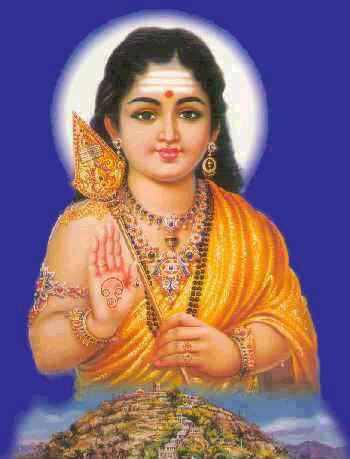TAMIL NATION LIBRARY: Literature - *The Smile of Murugan : On Tamil Literature of South India, Zvelebil Kamil
Published by V.Leiden, E. J. Brill, 1973, 378 pages. * indicates link to Amazon.com online bookshop [see also Prof. Dr. Kamil Vaclav Zvelebil ] From the Dedication and Preface: The great drums beat
As Asura warriors marched.
Their burning rage cut asunder
Corpses scattered
Scorched with a spark from your radiant smile
O leader of men
With leaf-edged spear
Lover of Valli the gypsy
O lord who resides on Tiruttani hills!
(Arunakiri, Tiruppukal 5.7I) Transl. S. Kokilam
 "Somehow or other, Murugan, the youthful god of victorious war, is ubiquitous in Tamil writing and culture; he is present in the earliest classical poems of Tamil as well as in the splendid "Lay of the Anklet", in the ruby-red and sea-blue and golden songs of Arunakiri as well as in the very recent prayers to Murugan by A. K. Ramanujan. His wars are, of course, not only victorious, but just. He destroys evil, decay, death. His smile is the light of life and eternal youth. "His face shoots forth myriad rays of light, removing darkness from the world" (Tirgmurkarruppatai 91-92)." [see also Suran Por, a poem in Tamil by Raj Swarnan] "Somehow or other, Murugan, the youthful god of victorious war, is ubiquitous in Tamil writing and culture; he is present in the earliest classical poems of Tamil as well as in the splendid "Lay of the Anklet", in the ruby-red and sea-blue and golden songs of Arunakiri as well as in the very recent prayers to Murugan by A. K. Ramanujan. His wars are, of course, not only victorious, but just. He destroys evil, decay, death. His smile is the light of life and eternal youth. "His face shoots forth myriad rays of light, removing darkness from the world" (Tirgmurkarruppatai 91-92)." [see also Suran Por, a poem in Tamil by Raj Swarnan]
"The Dravidians, and in particular the Tamils, have contributed a great deal to the cultural riches of the world: Pallava and Chola temple architecture, Chola bronze sculpture, the dance-form known as Bharatanatyam, the so-called Carnatic system of music. But probably the most significant contribution is that of Tamil literature, which still remains to be "discovered" and enjoyed by the non Tamilians and adopted as an essential and remarkable part of universal heritage. If it is true that liberal education should "liberate" by demonstrating the cultural values and norms foreign to us, by revealing the relativity of our own values, then the "discovery" and enjoyment of Tamil literature, and even its teaching (as a critical part of the teaching of Indian literatures) should find its place in the systems of Western training and instruction in the humanities.
However, frankly speaking, I do not think that anybody is capable, at the present state of affairs, of bringing out a sufficiently formalised, detailed and exhaustive synthesis of Tamil literature comparable to such magnificent works as, say, Jan Rypka's Persian Literature or Maurice Winternitz's History of Indian Literature....
Distinctive features of Tamil Literature... ".... it is clear that Tamil literature did not develop in a cultural vacuum, and that the evolution of the Tamil culture was not achieved either in isolation, or by simple cultural mutation. The very beginnings of Tamil literature manifest clear traces of Aryan influence - just as the very beginnings of the Indo-Aryan literature, the Rig vedic hymns, show traces of Dravidian influence. This, too, is today an undisputed fact.
On the other hand, there are some sharply contrasting features which are typical for Tamil classical culture alone, for the Tamil cultural and literary tradition as opposed to the non-Tamil tradition - and in this respect, the Tamil cultural tradition is independent, not derived, not imitative; it is pre-Sanskritic, and from this point of view Tamil alone stands apart when compared with all other major languages and literatures of India.
It is possible to express this fact briefly but precisely by saying that there exist in India only two great specific and independent classical and historically attested cultures - the Sanskritic culture and the Tamil culture.
Historically speaking, from the point of development of Indian literature as a single complex, Tamil literature possesses at least two unique features.
First, as has just been pointed out, it is the only Indian literature which is, at least in its beginnings and in its first and most vigorous bloom, almost entirely independent of Aryan and specifically Sanskrit influences. This primary independence of Tamil literary tradition has been, incidentally, the source of many conflicts.
Second: though being sometimes qualified as a neo-Indian literature, Tamil literature is the only Indian literature which is both classical and modern; while it shares antiquity with much of Sanskrit literature and is as classical, in the best sense of the word, as e.g. the ancient Greek poetry, it continues to be vigorously living modern writing of our days. This fact was expressed in a very happy formulation by A. K. Ramanujan in his excellent book The Interior Landscape (1967): 'Tamil, one of the two classical languages of India, is the only language of contemporary India which is recognizably continuous with a classical past.'..."
|